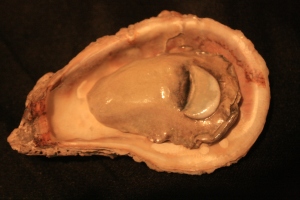By Chris Smith
The Southern Food and Beverage Museum’s case devoted to artifacts from the World’s Fair has a new item – an artificial oyster made by a local artist that was a precursor to today’s fake food industry.
The oyster is on loan from the artist, Alberta Lewis, a ceramist who lives at Sebastopol Plantation in St. Bernard Parish. The shell is real – a Louisiana oyster selected by Lewis herself for its unique beauty. But the “meat” of the oyster was Lewis’ own creation, a clay representation of the mollusk rendered in brown, black, taupe, green and even blue.
“The color was the big challenge,” she recalls. “It had to look natural and give a representational idea of what an oyster looked like to all of the people who would see it in New York.”
Yes, New York but more specifically the borough of Queens, the site of the 1964 World’s Fair, which predated the New Orleans World’s Fair by exactly two decades. The fair’s theme was “Peace Through Understanding,” dedicated to “Man’s Achievement on a Shrinking Globe in an Expanding Universe.” The fair featured 140 pavilions on 646 acres.
One of those pavilions was created by the state of Louisiana which recreated New Orleans’ Bourbon Street inside its pavilion complete with jazz musicians that performed in the restaurants that lined the street. Another attraction was the Gas Pavilion, which included a “Theatre of Food” with demonstrations by chefs from all over the world.
At one of these pavilions, Lewis does not remember which one, demonstrators from the New Orleans Public Service Incorporated (NOPSI) were showcasing a classic local creation, Oysters Rockefeller, a huge hit at the fair.
The oysters were a huge hit with the people who watched NOPSI demonstrators prepare them. However, they oysters had become a significant issue for food inspectors in New York. In order to make the dish, oysters were shipped regularly from New Orleans and were prepared for cooking. According to Lewis, the food inspectors wanted to put warning signs alongside the dish. Also, it was expensive to constantly ship oysters to New York for the demonstrations.
The solution was to create fake oysters that looked as realistic as possible. The NOPSI demonstrators could then place the oyster on the shell, prepare the spinach and cheese concoction to cover the oyster, and then pop the dish in to the oven. Because the fake oysters were made of porcelain, they could withstand the heat of the oven and could be washed after each demonstration.
“I was contacted by an acquaintance who knew I worked in clay and who wanted to know if I could make ceramic oysters,” she recalls. “My challenge was to make a dozen oysters that looked like real oysters. The oyster shells were easy. The meat was the tough part.”
Lewis began to experiment, mixing different color combinations into her clay, and creating different glazes that would replicate the watery sheen of a freshly opened oyster.
“The color had to be natural,” she said. “I had to capture the translucency of an oyster. It couldn’t look dry; it needed to look fresh. The eye, where the oyster is attached to the shell, had to look realistic and not too opaque. The edges needed to have darker edges in order to look realistic. I ended up using several different methodologies until I got something that worked.”
It didn’t take her long to create a suitable oyster. When she thought she had the right formula, she made 12 of the faux oysters and packed them off to New York. “They were accepted and I was paid for my work. That was the last I heard from them.”
But she kept one of the extra replicas, the piece that is now on loan to the museum. After almost 50 years, it remains as fresh and translucent as the day Lewis created it, making one wonder why she didn’t try to create a pearl.
Tags: Chris Smith, Sebastopol Plantation, Southern Food and Beverage Museum, Stephanie Jane Carter

March 17, 2010 at 5:11 am |
Chris Smith accurately captured my ‘ceramic oyster birthing’ with the entertaining spin of a seasoned storyteller! Reading this was like looking at a 1960’s snapshot of the oyster’s creation, taken over my shoulder while at work in the studio,. The oysters were a fun project, and little did I think that Oyster #13 would take its place in history almost 50 years later in one of SOFAB’s distinctive displays for visitors to enjoy and appreciate the oyster’s delectable position in the heritage of our Southern table . I am honored that it can contribute to the purpose and success of our Southern Food and Beverage Museum, a unique, one of a kind collection celebrating a cornucopia of foodways from this and other regions.
May 21, 2010 at 8:40 pm |
[…] Collections Update: Alberta’s Oyster […]
March 4, 2011 at 8:24 pm |
Mr. Ivy Billiot in Terrebonne Parish makes faux oysters that you would swear are real, they look like you could just suck it right off the shell.